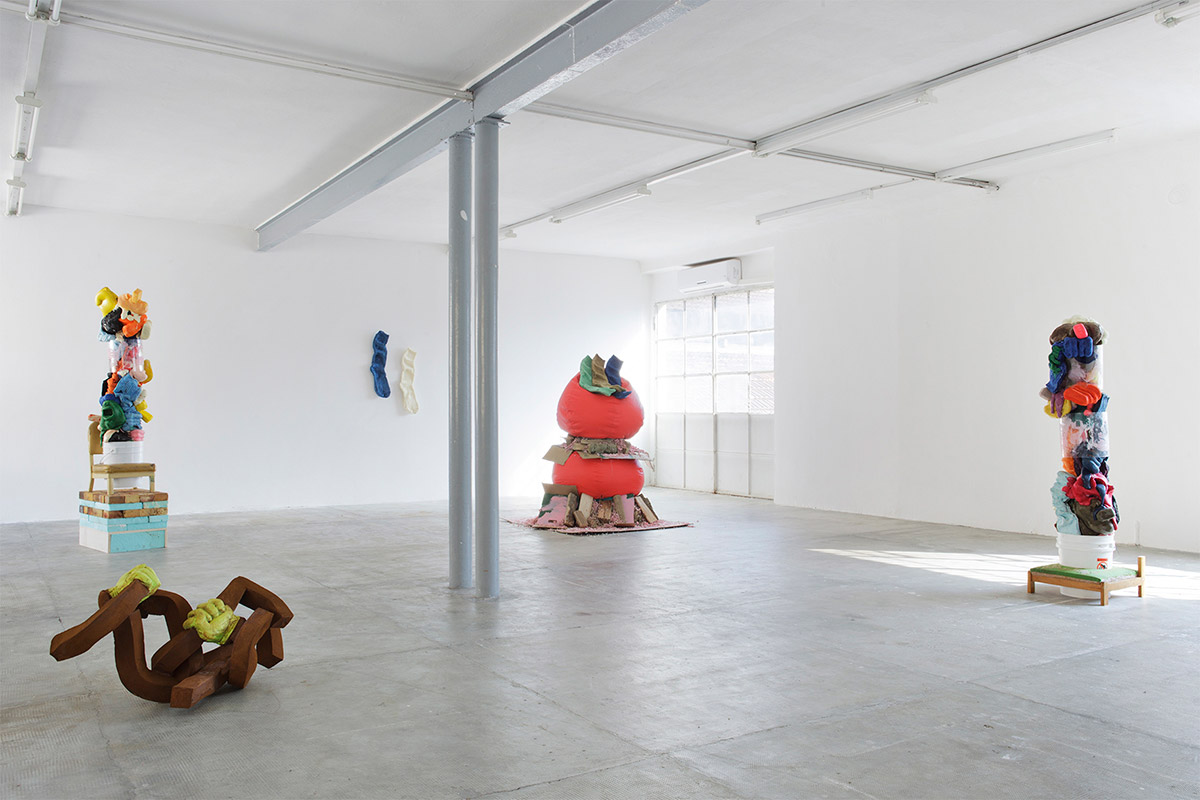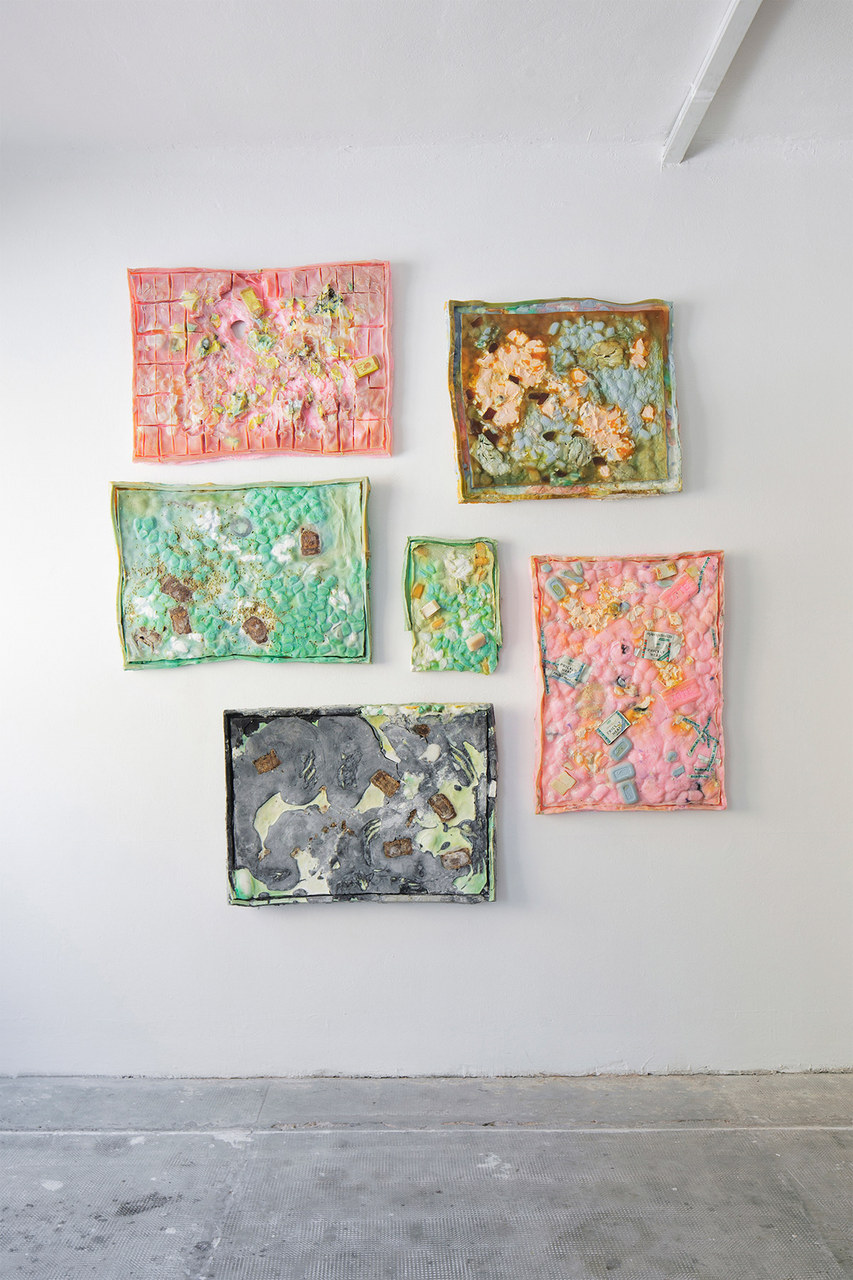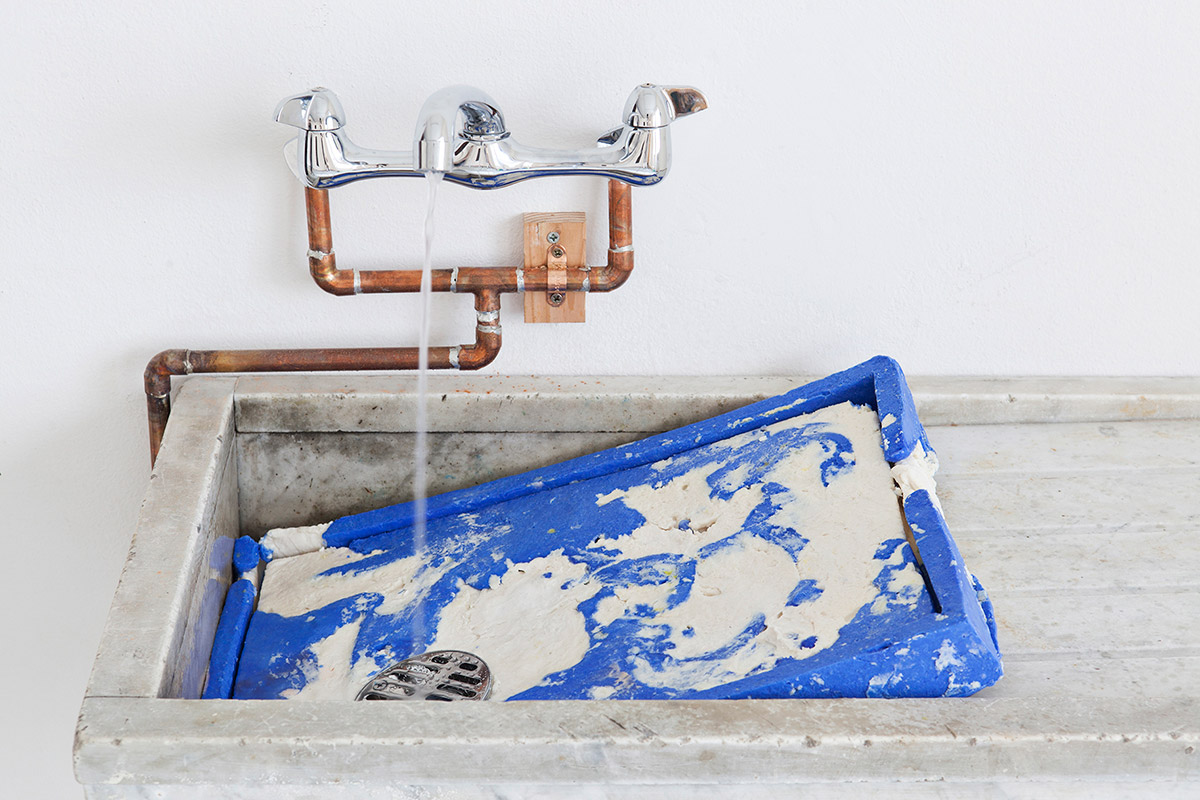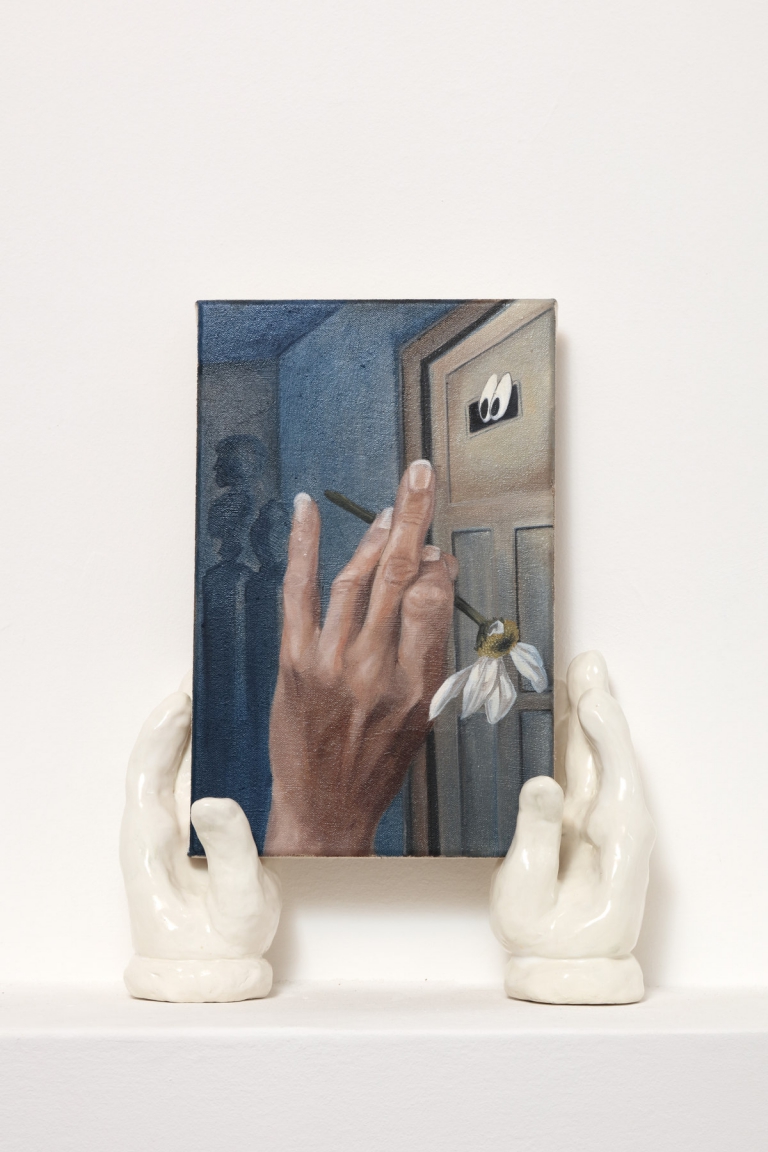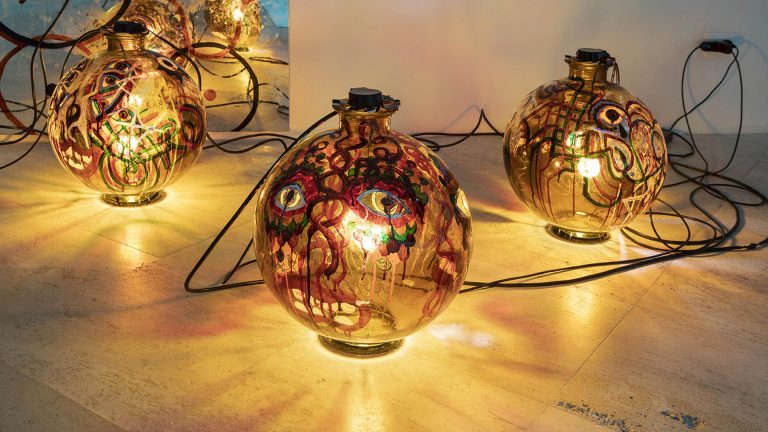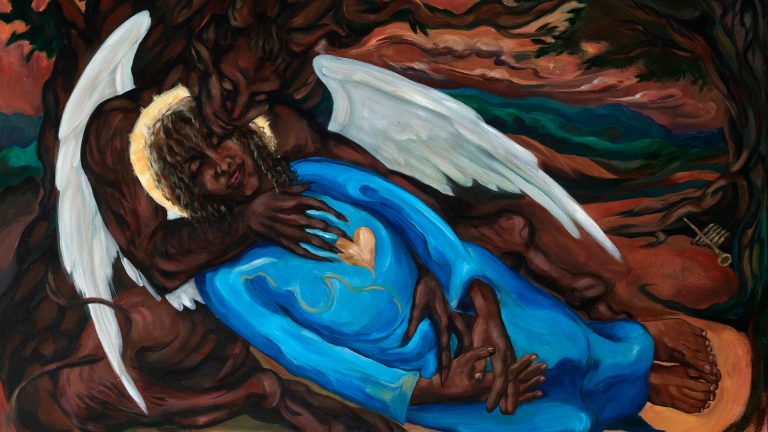
Artist: Catharine Ahearn
Exhibition title: NO SOAP RADIO
Venue: Peep-Hole, Milan, Italy
Date: February 20 – March 28, 2015
Photography: Laura Fantacuzzi. Courtesy of the artist and Peep-Hole
Peep-Hole presents the first exhibition in an institution by the artist Catharine Ahearn.
Catharine Ahearn, through constant experimentation with techniques and materials, investigates the narrative potential of everyday life and the relationship with the body to construct a layered imaginary that takes form through unusual, sarcastic reinterpretations of reality. Drawing on experiences or characters rooted in collective memory, she combines ordinary objects in visionary and mysterious compositions that ironically address the stereotyped dynamics of power.
NO SOAP RADIO consists of a series of sculptures and paintings created for the exhibition, whose itinerary is paced and forcefully characterized by a large environmental installation around which Ahearn has developed the whole project. The multiplicity of languages and vast range of material utilized – from the most ephemeral, like soap, to others with a profoundly different nature, like iron – offer an experience of the thematic and linguistic paths on which her practice is based.
The site-specific intervention is an elliptical PVC curtain that invades the gallery like an enormous spaceship, crossing it lengthwise from the first to the last room, separating and at the same time connecting the various zones. As in an intermezzo or a pause between scenes, The Mother (2015) sets the rhythm of the narration: every time viewers cross it, they find themselves in a new space, while at the same time each space is linked back to its predecessor.
The exhibition path begins with an element that acts as an introduction to the whole project: a common washstand, containing a painting made with soap, with water flowing continuously on its surface. On the opposite side of the same wall one sees a second washstand, almost identical to the first. These ordinary furnishings, positioned against the wall as if they had always been there, create a mysterious atmosphere, emphasized by the unnatural symmetry of the two elements, and the continuous flow of the water that melts the soap of the paintings. As in early works by the artist – such as the Lava lamps shown in 2013 in her solo show at Ramiken Crucible in New York – here too the material is in constant movement, continuously transformed and slowly consumed. Ahearn chooses soap for its intrinsic characteristics, which lend themselves perfectly to her intention to investigate processes of creation, destruction, recycling of the form – and of the idea – by means of “labor,” a reflection that forms the basis of the entire show.
While the washstands in the first room point explicitly to a cyclical process, the works in soap in the next space, installed on the wall as befits a painting, reveal their sarcastic nature. In the failed attempt to achieve the ideal beauty and fulfilled form of the painting, these works become a parody of the painting itself, and a way of questioning the present status of that art form.
Similar reflections lie behind the three paintings March 1924 (2014), in the first room, The girl who loved death (2014) and Well of the worlds (2014), in the last space, closed inside screens of black plexiglas that entirely cover the painted surface, making perception of the painted images almost impossible. The painting is “erased” by the dark, reflecting surface of the plexiglas that not only hampers viewing of the image below, but also superimposes the reflected image of its surroundings.
Inside the exhibition the choice of a material like soap has a dual semantic value, which has to do on the one hand with the intrinsic qualities of the material itself – ephemeral and perishable – and on the other with the symbolism and metaphorical overtones of this everyday useful article, and its implications in the collective imagination, connected with punishment. The soap in the mouth of No Soap Radio (2014) and the bars of soap in socks of Big Beater (2014) and Beater Barrow: labor of punishment (2014), explicitly evoke certain forms of punishment Ahearn uses to reflect on the idea of “labor.” If the soap paintings have to do with “labor” seen as a process behind the creation of a work, these sculptures speak of a “labor” understood as effort: the physical effort of hard manual labor, and the mental effort involved in performing a task and playing a social role. The boot and the barrow are two objects symbolizing “hard work” that associated with the imagery of punishment represent the effort of imposing a rule, of performing a task and playing a role, which for the artist is that of someone who engages in a labor commonly perceived as pure pleasure.
Bean Bag Burn: punishment of leisure (2015), where two red Sacco chairs are stacked to form an imaginary bonfire, comes precisely from thinking about the stereotypes connected with the figure of the artist and the way in which the artist’s labor is perceived within the society.
In contrast with the “levity” evoked by Bean Bag Burn: punishment of leisure, the fists that twist the iron forms of Smash 3 (2015) are an ironic take on the figure of the sculptor, compared to the Hulk, an infantile and threatening ball of rage. In a mixture of high and low culture, the reference to Marvel comics overlaps with reminders of the elegant twisting of the monumental sculptures of Clement Meadmore and Eduardo Chillida.
The focus on the ordinary, the cliché, the commonplace, and the desire to make light of the mechanisms that generate them, are motifs that recur throughout the show, as already emphasized by the title, NO SOAP RADIO, which refers precisely to standardized social behaviors and the mechanisms of psychological conditioning to which individuals respond within a group. “No soap, radio” is actually the senseless punchline of an intentionally unfunny joke, used as a psychological experiment to demonstrate how much the reaction of an individual – laughter, in this case – can be influenced by the reactions of others.
The sarcasm of the title is a good example of the approach that marks all the output of Catharine Ahearn, whose works are like provocative pranks that trigger a short-circuit between form and content, throwing viewers off balance and challenging their cognitive and interpretative capacities.
Catharine Ahearn (Johannesburg, 1985), lives and works in Los Angeles. She studied at New York University. She has had a solo show in 2013 at Ramiken Crucible, New York. In 2014 she participated in many group shows, including: Next, Arsenal, Toronto, Canada; MFA 2015 Exhibition, UCLA New Wight Gallery, Los Angeles; Nuit Américaine, Office Baroque, Brussels; Chat Jet – sculpture in reflection Part 2, Künstlerhaus, Graz; Everything falls faster than an anvil, Pace Gallery, London; Imitatio Christie’s (partoftheprocess6), Galleria Zero…, Milan, 2014.


